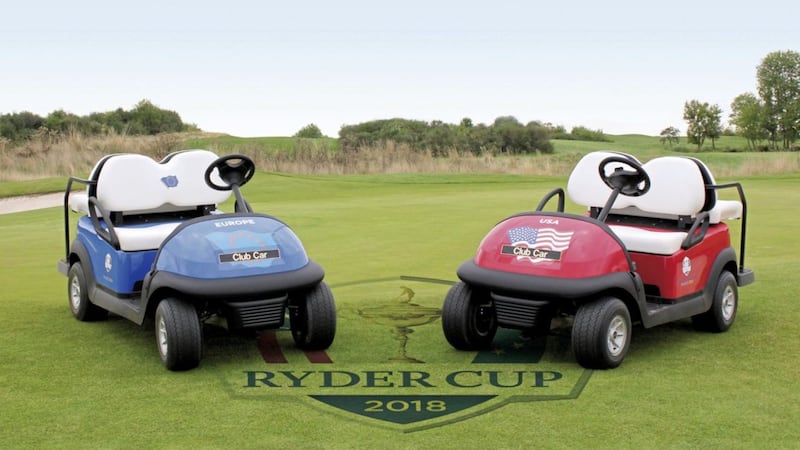I'M STANDING on the seventh tee of a golf course. I look right. Cornfields stretch towards woods. Forest and farmland as far as the eye can see. I look left. Undulating dunes, waving grasses, thick rough.
I could be on a links in Ireland. But I'm on the Albatross course (l'Albatros) of Le National golf complex, 20 miles west of Paris, on the edge of Versailles. A 17th century gatehouse, visible on the course, marks the beginning of Louis XIV's vast domain.
A Louis XIV gatehouse is perhaps the least surprising feature of Le National, where the 2018 Ryder Cup will be played. Twenty-seven years ago, all the land here was flat. Le National's three courses were sculpted from farmland. They were the brainchild and design of a former director of the French Golf Federation, and golf architect, Hubert Chesneau. His dream was to create French champions, and a permanent home for the French Open. For the creation of champions he set up a Golf Academy. For the French Open championship course, l'Albatros, he brought in the world-renowned golf architect, Robert Von Haage to make the final touches.
Until the 1980s, golf in France was an elite sport played at private clubs such as Chantilly, Fontainebleau and Morfontaine – built by a Duke, designed by Tom Simpson (Ballybunion and Lytham St Anne's).
"Golf was the preserve of the rich," says the director of Le National, Paul Armitage – born and educated in England but based in France since 1991. "They brought in great architects. They built fantastic courses. All private. Then, in the 1980s, EU subsidies meant a lot more courses got built. But there weren't enough golfers. Tourism didn't promote French golf. The image of France was still the beret and the baguette. Golfers flew over France to play in Spain and Portugal. The boom in golf courses came too late for France."
That has changed. While I was chatting to Paul Armitage, officials from French tourism offices all over the world were at the complex discussing promoting France as a golfing destination. Later, I was to meet a three-ball from Louisiana, and a four-ball from Yorkshire. A first-time golfing break in France for all of them.
Le National was the game changer. The complex is owned by the French Golf Federation. It's pay and play on all three courses – the Albatross, the less difficult Eagle, and the nine hole Oiselet (Birdie). It's a public course. There are no members. But there's a golf academy with 100 teaching bays a huge practice area (4,000 square yards of short game plus driving range), and an amphitheatre for seminars and lectures.
Three hundred lorries per day for three years carried soil and rubble from house-building in the area to landscape the three courses. The lakes on the course are part of a drainage system which allows fast, links-style drying-out after rain – which can be plentiful in this part of France.
Paul Armitage came to Le National in 2014. Le National had already won the bid to host the Ryder Cup 2018.
"We made changes for the Ryder Cup," he says. "We had to avoid what happened at Celtic Manor in 2010 when they had to play on the Monday. We absolutely have to avoid closing for rain. So we re-did the drainage and irrigation – especially the drainage – in 2015-16.
"We made architectural changes as well. Two greens weren't set up. You need more than five or six pin positions. You need different ones for the practice days and the days of play. Two each for the Friday and Saturday when you have play in both morning and afternoon.
"Then there are the logistics of modern tournaments – spectator amenities, cabling for television, toilets, car parks. We made the course more fluid for spectators with 12 kilometres of paths. We put in drinking water and fibre optics."
I set out to walk l'Albatros with Le National golf professional, Jean-Pierre Marzelle, coach to the French national team, and my husband, Richard – for whom a round on the Ryder Cup course with a professional, was a surprise birthday present from me.
The course is visually striking from the start. The first two holes – a par four and par three – wrap around a lake.
On the par four first, Richard's drive lands in the middle of the fairway. Jean-Pierre nods approval. Richard's second ball lands in the water. Jean-Pierre makes him take the shot again. The second ball lands in the water.
I realise why the friendly and enthusiastic assistants in the pro-shop – all fluent in English – sell packs of 12 lake balls (pristine). Why, even for a 15 handicapper, they suggest taking a second pack "just in case."
And why one of them, Nelson (a 3-handicapper on work experience from school in Paris) told us, "you play this course for the experience, not for the score."
Richard's third, successful, shot leaves a difficult downhill put towards a lakeside flag. The ball drops into the hole. Phew! What a start.
The second is a par 3 across the lake to a green well-guarded by bunkers. Richard's ball flies over the lake and lands in a bunker at the back. He gets away with a bogey.
Fortunately the course now turns away from water, allowing the nerve-shattered golfer to regain confidence. The sun is shining and there is almost no wind.
"The fourth is a monster when the wind is blowing," says Jean-Pierre cheerfully.
A par five and a series of long par fours wind through undulating mounds, past bunkers to difficult, domed greens. There are few trees. Occasionally, the land rises to give a view of the surrounding farmland, flat as far as the eye can see, a reminder of just how much earth was shifted to create this course, and its sister courses, L'Aigle and l'Oiselet, 29 years ago. There is water everywhere, though not necessarily in play, a clue to the complicated drainage system that gives these courses their linksy feel.
It's a great spectator course. The man-made, undulating hills and dunes provide viewpoints on every hole – as I notice when scrambling up them to help find lost balls.
Jean-Pierre is charm and patience personified. The round is, in effect a lesson. He makes Richard see his occasional fading of the ball as a positive. "You see. You know how to do this. Now you can do it only when you need it."
He gives us tips for playing from the thick fringes to the greens, and from bunkers.
And exercises to hone the golf swing – such as finishing with the club over the right shoulder, to encourage a good turn.
There are several holes on l'Albatros where the choice between safety and glory will add drama to the matchplay format of the Ryder Cup. Take the 13th, a par-four dog-leg with an approach to the green over water and through a narrow gap in the trees. From the back tee it will be a fairway wood and a mid-iron onto the green. But the tee positions range from 425 yards to a mere 340. From the forward tee it will be bash and splash for sure.
The 15th heralds a dramatic run of holes to the finish, a long par four along a lake with an approach to an island green. A clue is in its title – 'Le Juge' (Judgment). The 16th is a 180- yard par three along and across water, the drama changing with both designated tee box and pin position.
The 17th may appear to offer some respite, but at 480 yards with no bunkers this is sure to encourage some gung-ho driving. The 18th is of similar length, but with water everywhere and an island green. Heroics expected.
FACT FILE
:: Roisin and her husband flew from Dublin to Paris Beauvais/Tillé with Ryanair. Le National golf course is 1hr 20 minutes drive from the airport
:: Details of how to play Le National, (with, or without professional help) at golf-national.com



